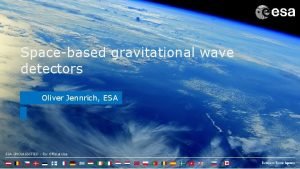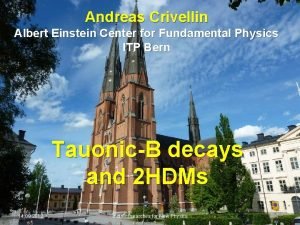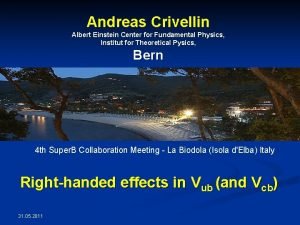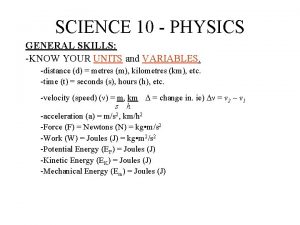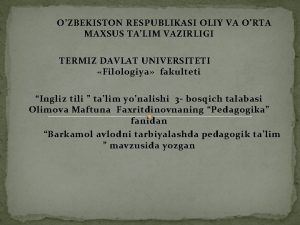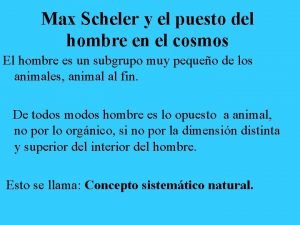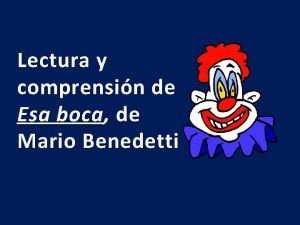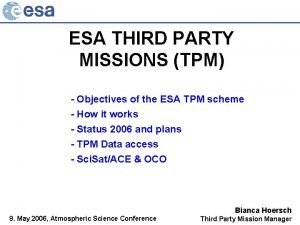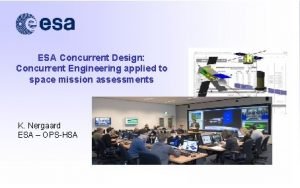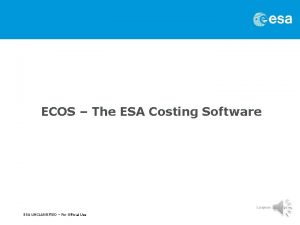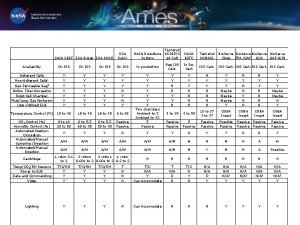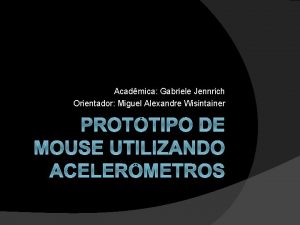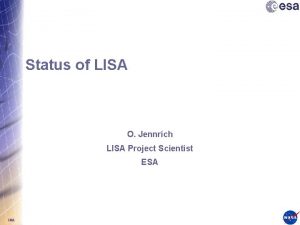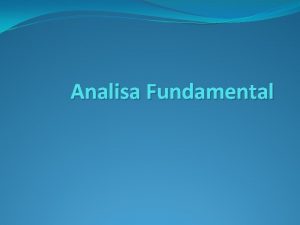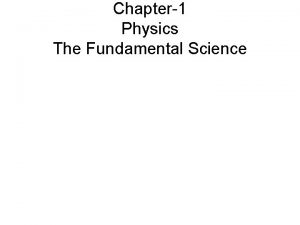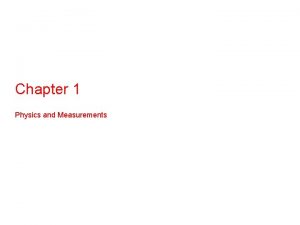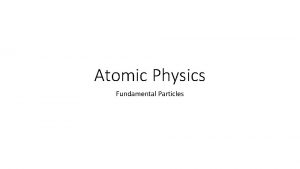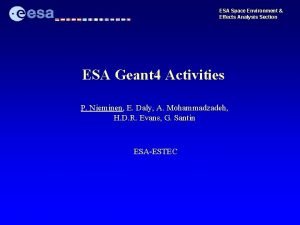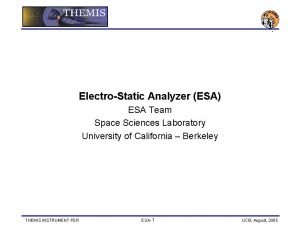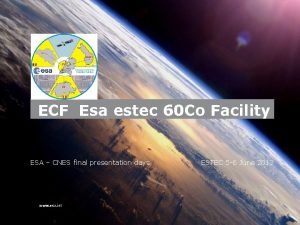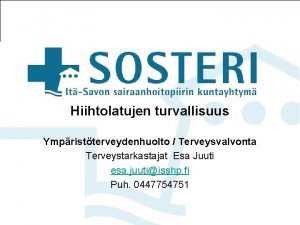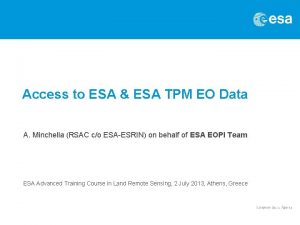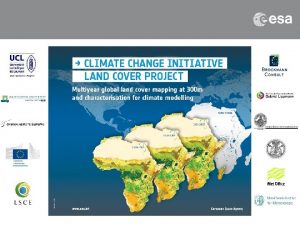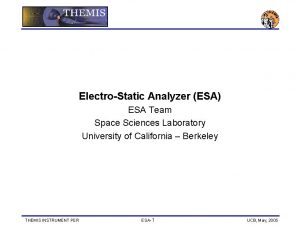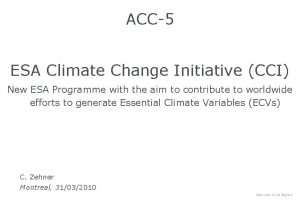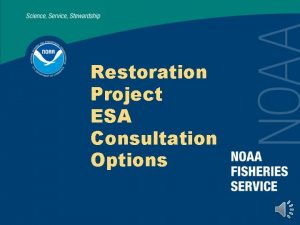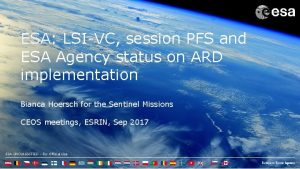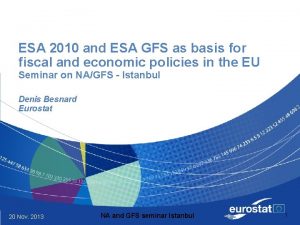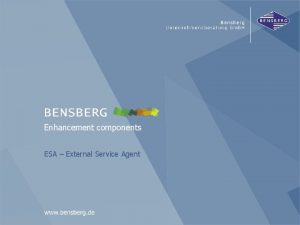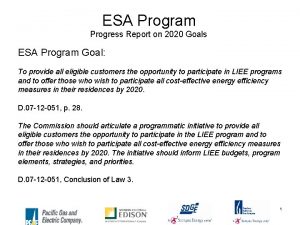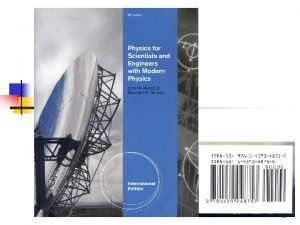Fundamental Physics at ESA O Jennrich ESA Science






























- Slides: 30

Fundamental Physics at ESA O. Jennrich ESA Science Directorate

Overview q Two dedicated missions in the Science Directorate · LISA Pathfinder · LISA q Missions with aspects of FP in the Science Directorate · Gaia · Planck q Mission concepts under assessment · Fundamental Physics Explorer q Minor contributions to nationally led missions · Microscope (CNES) q Missions in other Directorates but supported through Science Directorate · ACES (led by Human Spaceflight) Space. Part 06 – Beijing – 19 April 2006 Page 2

ACES Space. Part 06 – Beijing – 19 April 2006 Page 3

ACES mission q ESA mission conducted by Human Spaceflight q To be installed on the ISS (Columbus module) q Payload · Cs fountain clock (PHARAO) · Hydrogen maser (SHM) · Microwave link q Mission goals: · Test of a new generation of space clocks · Precise and accurate time and frequency transfer · Fundamental physics tests q Status: payload development q Launch: 2010 Space. Part 06 – Beijing – 19 April 2006 Page 4

Microscope q CNES-led mission to investigate the equivalence principle · Target sensitivity 10 -15 · Room-temperature experiment q Measurement principle: · compare the effect of gravity on two masses of different material · 2 differential accelerometers in free-fall (Pt. Rh/Pt. Rh and Ti/Pt. Rh) Space. Part 06 – Beijing – 19 April 2006 Page 5

Microscope q ESA contributes μN thrusters (FEEP) q ONERA: inertial sensor development q Development status · Satellite PDR February 2006 q Launch · May 2010 Space. Part 06 – Beijing – 19 April 2006 Page 6

Planck q Measuring the CMB with unprecedented accuracy · T/T = 2 × 10 -6 (about 10 times better than WMAP) · Angular resolution 5 arcsec (24 μrad) (about 3 times better than WMAP) · Wide frequency coverage (30– 857 GHz). q Payload · Low Frequency Instrument (LFI) • Intensity and polarization at 33 GHz, 44 GHz and 70 GHz • Cryogenic detectors (20 K) · High Frequency Instrument (HFI) • Bolometric measurements (intensity and polarisation) at 6 frequencies at 100 – 857 GHz • Detector temperature 0. 1 K Space. Part 06 – Beijing – 19 April 2006 Page 7

Planck q Fundamental physics with Planck · Nature of Dark Energy and Dark Matter · Baryogenesis · String theory q Status · Payload flight models under test, delivery to ESA July/August 2006 q Launch · Foreseen Q 1 2008 (joint launch with Herschel on Ariane 5) Space. Part 06 – Beijing – 19 April 2006 Page 8

Gaia – Taking a census of the galaxy q Astrometric mission to measure positions, distances, and space motions of stars in our galaxy · About a 109 stars up to magnitude 20 · median parallax errors: 7 μas at 10 mag; 20 -25 μas at 15 mag; 200– 300 μas at 20 mag · Distance accuracy: between 1% and 10% · Velocity accuracy: between 0. 5 km/s and 10 km/s q Status · Implementation phase q Launch · December 2011 Space. Part 06 – Beijing – 19 April 2006 Page 9

Gaia science objectives q q q Galaxy origin and formation; Physics of stars and their evolution; Galactic dynamics and distance scale; Solar System census; Large-scale detection of all classes of astrophysical objects including brown dwarfs, white dwarfs, and planetary systems; q Fundamental physics Space. Part 06 – Beijing – 19 April 2006 Page 10

Fundamental Physics with Gaia q Determine PPN parameters · |1 - | < 5× 10 -7 · |1 - |< 3× 10 -4 q Solar quadrupol moment J 2 to 10 -7– 10 -8 q Variability of the gravitational constant t. G/G to 10 -12– 10 -13 yr-1 q Constraints on gravitational wave energy at frequencies between 10 -12 Hz and 4× 10 -9 Hz q Constraints on M and from quasar microlensing Space. Part 06 – Beijing – 19 April 2006 Page 11

LISA PF q Precursor to LISA q Demonstrating critical technologies for LISA · Drag-free · Thrusters · Interferometry q Single spacecraft in Lissajou type orbit around L 1 q Mission duration 6 months q Mission status: · Mission PDR successful in February 2006 · Flight hardware delivery Summer 2006 · Launch in Q 4 2009 Space. Part 06 – Beijing – 19 April 2006 Page 12

LISA PF q Payload · Payload consists of a European contribution • • Two gravitational reference sensors Interferometric measurement system Drag free control system μN thruster · US contribution • Disturbance reduction system – descoped! • Drag free control system and μN thruster Space. Part 06 – Beijing – 19 April 2006 Page 13

LISA PF Inertial Sensor Space. Part 06 – Beijing – 19 April 2006 Page 14

LISA PF IMS Space. Part 06 – Beijing – 19 April 2006 Page 15

LISA q Mission to detect and observe gravitational waves and their sources q Joint ESA/NASA mission · Europe: Payload, Payload integration, propulsion module · NASA: Payload, Payload integration, Spacecraft, launcher, operations · Science operations will be conducted jointly q Technological challenges · Interferometric measurements to picometer accuracy · Drag-free technology · Low frequency stability q Definition/Development: 2010 after completion of LISA PF q Launch date ~2017 (present planning assumption) Space. Part 06 – Beijing – 19 April 2006 Page 16

LISA mission concept q Cluster of 3 spacecraft in a heliocentric orbit · Spacecraft shield the test masses from external forces (solar wind, radiation pressure) · Allows measurement of amplitude and polarisation of GW Space. Part 06 – Beijing – 19 April 2006 Page 17

LISA mission concept q Cluster of 3 spacecraft in a heliocentric orbit q Trailing the Earth by 20° (50 million kilometers) · Reducing the influence of the Earth-Moon system on the orbits · Keeping the communication requirements (relatively) standard Space. Part 06 – Beijing – 19 April 2006 Page 18

LISA mission concept q Cluster of 3 spacecraft in a heliocentric orbit q Trailing the Earth by 20° (50 million kilometers) q Equilateral triangle with 5 million kilometers arm length · Results in easily measurable pathlength variations · Orbit is still stable enough to allow for mission duration larger than 5 years Space. Part 06 – Beijing – 19 April 2006 Page 19

LISA mission concept q Cluster of 3 spacecraft in a heliocentric orbit q Trailing the Earth by 20° (50 million kilometers) q Equilateral triangle with 5 million kilometers arm length q Inclined with respect to the ecliptic by 60° · Required by orbital mechanics Space. Part 06 – Beijing – 19 April 2006 Page 20

LISA Science Goals q Determine the role of massive black holes in galaxy evolution q Make precision tests of Einstein’s Theory of Relativity q Determine the population of ultracompact binaries in the Galaxy q Probe the physics of the early universe q Merging supermassive black holes q Merging intermediatemass/seed black holes q Gravitational captures q Galactic and verification binaries q Cosmological backgrounds and bursts NASA/CXC/MPE/S. Komossa et al. K. Thorne (Caltech) Space. Part 06 – Beijing – 19 April 2006 NASA, Beyond Einstein Page 21

Call for CV Mission Proposals (1) q First of 3 Calls (TBC) for implementation of CV 2015 -2025 q Available budget for a ~2016 launch: ~320 M€ (1 effective budget year) q The Call will nevertheless be fully open: · No a priori size restriction, but clear cost guidelines · Mission could be • a small/medium size S/M mission (≤ 320 M€ cost to ESA) • a large ESA alone L mission (≤ 650 M€ cost to ESA) · Selection of L mission will serve for long term technological development for mission launch in 2020 q Up to 2 S/M (depending on size) + 1 L missions will eventually be implemented Space. Part 06 – Beijing – 19 April 2006 Page 22

Schedule of Call for proposals q Call for mission proposals released 22 May 2006 q Letters of Intent due 6 June 2006 q Briefing to proposers at ESTEC 12 June 2006 q Mission proposals due 18 Sep 2006 q WG select 3 S-M & 3 L missions for study phase October 2006 All dates to be confirmed! Space. Part 06 – Beijing – 19 April 2006 Page 23

LISA Space. Part 06 – Beijing – 19 April 2006 Page 24

Backup slides

ACES Mission Objectives I ACES Mission Objectives ACES performances Scientific background and recent results Test of a new generation of space clocks Cold atoms in micro-gravity Study of cold atom physics in microgravity Essential for the development of atomic quantum sensors for space applications (optical clocks, atom interferometers, atom lasers) Test of the space cold atom clock PHARAO Frequency instability: < 3∙ 10 -16 at 1 day Inaccuracy: ~ 10 -16 Short term frequency instability evaluated by direct comparison to SHM. Long term instability and systematic frequency shifts measured by comparison to ultra-stable ground clocks. Frequency instability: optical clocks surpass PHARAO by one or more orders of magnitude. Inaccuracy: at present, cesium fountain clocks are the most accurate frequency standards. Test of the space hydrogen maser SHM Frequency instability: < 2. 1∙ 10 -15 at 1000 s < 1. 5∙ 10 -15 at 10000 s Medium term frequency instability evaluated by direct comparison to ultra-stable ground clocks. Long term instability determined by on-board comparison to PHARAO in FCDP. Performances of state-of-the-art masers Space. Part 06 – Beijing – 19 April 2006 sy (1000 s) sy (10000 s) GALILEO 3. 2∙ 10 -14 1. 0∙ 10 -14 EFOS C 2. 0∙ 10 -15 Maser Page 26

ACES Mission Objectives II ACES Mission Objectives ACES performances Scientific background and recent results Precise and accurate time and frequency transfer Test of the time and frequency link MWL Time and frequency comparisons between ground clocks Time transfer stability: < 0. 3 ps at 300 s < 7 ps at 1 day < 23 ps at 10 days Common view comparisons with an uncertainty level below 1 ps per ISS pass. Non common view comparisons at an uncertainty level of - 2 ps for 1000 s - 5 ps for 10000 s - 20 ps for 1 day Absolute synchronization of ground clocks Absolute synchronization of ground clock time scales with an uncertainty of 100 ps. Contribution to atomic time scales Comparison of primary frequency standards with accuracy at the 10 -16 level. Space. Part 06 – Beijing – 19 April 2006 At present, no time and frequency transfer link has performances comparable with MWL. Existing T&F links Time stability (1 day) Time accuracy (1 day) Frequency accuracy (1 day) GPS-DB 2 ns 3 -10 ns 4∙ 10 -14 GPS-CV 1 ns 1 -5 ns 2∙ 10 -14 GPS-CP 0. 1 ns 1 -3 ns 2∙ 10 -15 TWSTFT 0. 1 -0. 2 ns 1 ns 2 -4∙ 10 -15 These performances will allow time and frequency transfer at an unprecedented level of stability and accuracy. The development of such links is mandatory for space experiments based on high accuracy frequency standards. Page 27

ACES Mission Objectives III ACES Mission Objectives ACES performances Scientific background and recent results Fundamental physics tests Measurement of the gravitational red shift Absolute measurement of the gravitational red-shift at an uncertainty level < 50 ∙ 10 -6 after 300 s and < 2 ∙ 10 -6 after 10 days. Space-to-ground clock comparison at the 10 -16 level, will yield a factor 30 improvement on previous measurements (GPA experiment). Search for time drifts of fundamental constants Time variations of the fine structure constant a at a precision level of a -1 da / dt < 1 10 -16 year -1 Crossed comparisons of clocks based on different atomic elements to impose strong constraints on the time drifts of a, me /LQCD , and mu /LQCD. Search for violations of special relativity Search for anisotropies of the speed of light at the level d c / c ~ 10 -10. Measurements relying on the time stability of SHM, PHARAO, MWL, and ground clocks over one ISS pass. ACES results will improve previous measurements (GPS-based measurements, GPA experiment, measurements based on the Mössbauer effect) by at least one order of magnitude. Space. Part 06 – Beijing – 19 April 2006 Page 28

S-M Missions schedule Assessment phases Jan 2007 – Dec 2008 · Internal assessment phase in 2007 · Competitive industrial assessment in 2008 · Emphasis on payload, cost and risks Presentation to Working Groups for prioritisation April 2009 SSAC recommendation for selection April 2009 Selection of 2 missions May 2009 Preparation & release of ITT Jun-Dec 2009 Start of industrial Definition Phase Jan 2010 SPC approval for development phase 1 mission Jun 2011 Launch Space. Part 06 – Beijing – 19 April 2006 Mid-end 2016 Page 29

L Missions schedule Study and Technology development phase Jan 2007 – Jun 2010 WG review and prioritisation Sep 2010 SSAC recommendation for 1 L mission Oct 2010 Start Technology consolidation Phase Apr 2011 Start Definition Phase Apr 2013 Start Implementation phase Apr 2015 L Mission Launch Space. Part 06 – Beijing – 19 April 2006 ≥ 2020 Page 30
 Gwplotter
Gwplotter Esa multimedia.esa.int./multimedia/virtual-tour-iss
Esa multimedia.esa.int./multimedia/virtual-tour-iss My favorite subject is english because
My favorite subject is english because Albert einstein center for fundamental physics
Albert einstein center for fundamental physics Albert einstein center for fundamental physics
Albert einstein center for fundamental physics Arch loop whorl
Arch loop whorl Modern physics vs classical physics
Modern physics vs classical physics University physics with modern physics fifteenth edition
University physics with modern physics fifteenth edition Ia topics for physics
Ia topics for physics Science 10 physics review
Science 10 physics review Social science vs natural science
Social science vs natural science Main branches of science
Main branches of science Natural and physical science
Natural and physical science Applied science vs pure science
Applied science vs pure science Anthropology vs sociology
Anthropology vs sociology Science fusion think central
Science fusion think central Tragedy of the commons
Tragedy of the commons Julie lundquist
Julie lundquist Hard and soft science
Hard and soft science Perpustakaan esa unggul
Perpustakaan esa unggul Talimni tarbiyadan tarbiyani esa
Talimni tarbiyadan tarbiyani esa Max scheler pensamiento sobre el hombre
Max scheler pensamiento sobre el hombre Esa boca benedetti
Esa boca benedetti Sonrie pero no te escondas detras de esa sonrisa
Sonrie pero no te escondas detras de esa sonrisa Esa method
Esa method Esa and jj
Esa and jj Cdf esa
Cdf esa Costing
Costing Arti beriman dan bertakwa kepada tuhan yang maha esa
Arti beriman dan bertakwa kepada tuhan yang maha esa Amex esa
Amex esa Zrak je zmes plinov
Zrak je zmes plinov
